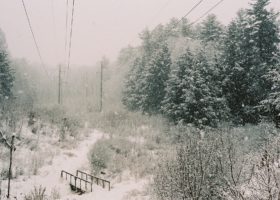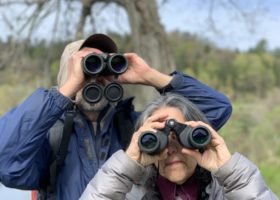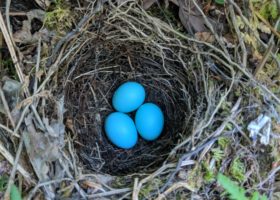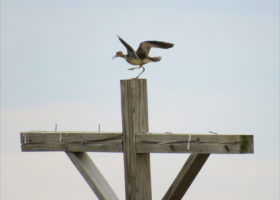
Vermont Center for Ecostudies Operations Update in Response to COVID-19
In light of the current public health crisis, we at VCE want to update you on our evolving operational changes, and let you know about steps we are taking to keep our staff, volunteers, and communities safe and healthy.

Rare Crested Caracara Visits Vermont
On March 23, 2018 Mark Bessette surprised the Vermont iNaturalist community. Mark had snapped some photographs of an unusual-looking bird that he dubbed, “Elvis, the juvenile bald eagle.” The bird appeared to have a black wig that reminded Mark of the “King of Rock and Roll,” Elvis Presley. The iNaturalist community was quick to weigh in on the real identity of this bird. To seasoned birders, it easily stood out as a misplaced Crested Caracara.

Narrowing Down the Whereabouts of Bicknell’s Thrush in Cuba
VCE’s 2020 field trip to eastern Cuba yielded many avian treasures, but no new Bicknell’s Thrush records. After four years, it is clear that the species specializes on cloud forests in Cuba, and that conservation efforts must continue to focus on core Hispaniolan winter habitats.

February 2020 Photo-observation of the Month
Congratulations to killamfarm for winning the February 2020 Vermont Atlas of Life iNaturalist photo-observation of the month. The image of a Common Raccoon (Procyon lotor) sleeping soundly under a blue sky captured the most attention by voters.

Field Guide to March 2020
March is a month of battles between warm and cold, between winter’s refusal to leave and spring’s insistence on coming. So, here are some signs of spring to look out for in this Field Guide to March.

VCE Colleague Yolanda León Receives Prestigious Conservation Award
Longtime VCE conservation partner and Advisory Council member Yolanda León recently made us all proud by receiving the prestigious 2019 Partners in Flight Individual Leadership Award.

A Serendipitous Orchard Oriole Extravaganza
A casual dusk bird walk during a layover in Panama City provided Chris Rimmer with an unforgettable birding experience, as he intercepted an unprecedented concentration of Orchard Orioles heading to a communal nighttime roost.

Outdoor Radio: The Annual January Thaw – Real or Fantasy?
In this episode of Outdoor Radio, Kent McFarland and Sara Zahendra begin inside the Fairbanks Museum and Planetarium in St. Johnsbury to talk with meteorologist Mark Breen about whether or not a January thaw exists. Spoiler alert…maybe?

January 2020 Photo-observation of the Month
Congratulations to Madison Alderman for winning the January 2020 Vermont Atlas of Life iNaturalist photo-observation of the month. The image of a Short-tailed Weasel cloaked in white and peering from a hole in a tree in Rutland, Vermont garnered the most votes.

Field Guide to February 2020
February marks an important turning point. Although winter may continue to grip us for a little while longer, the landscape is preparing for change. So here’s a Field Guide to February to keep your spirits up.

Vermont eBirders Gather Big Bird Data During County Quest
From day one when eBirders reported an incredible 73 bird species on a cold winter day to a Say’s Phoebe, a rare visitor found in late November, Vermont birders scoured the state to discover as many bird species as possible during the 9th annual Vermont eBird County Quest, and set some records along the way.

2019 Norwich Bird Quest Racks up 177 Species
Birders rose to the challenge in 2019, as the inaugural Norwich Bird Quest eclipsed its goal of 175 species found within town borders in a single year. Over 1,300 eBird checklists by 17 birders generated an impressive total of 177 species, with numerous surprises. The 2020 Quest is now underway, with even more ambitious goals!

Of Birds and Buckets: Nocturnal Flight Call Recordings Shine A Light on Migration Timing
Most of our knowledge regarding the migration timing of songbirds comes from birding observations made during the day, even though much of the actual migration occurs at night. Is this a problem? As it turns out, it might be.

Volunteers Help the Vermont Atlas of Life Build Biodiversity Big Data in 2019
From the first observation of 2019, a Barred Owl sitting on a deck, to a Christmas Fern laying on snow on the last day of the year, naturalists added over 100,000 biodiversity records to our rapidly growing database of life in Vermont.

Field Guide to January 2020
Although the days are slowly growing longer, life in the Northeast now finds itself in the coldest depths of winter. January is about survival. Wildlife that doesn’t migrate adapts instead in order to make it to spring. Here’s a few tidbits of natural history happening outdoors this month around you.

December 2019 Photo-observation of the Month
Congratulations to Craig Hunt for winning the December 2019 Vermont Atlas of Life iNaturalist photo-observation of the month.

Outdoor Radio: Wingless Winter Moths
In this episode of Outdoor Radio, Kent McFarland and Sara Zahendra are hiking back and forth on a hillside, waiting for the morning sun to warm the forest so they can spot the last moth of the year.

A Lifetime of Birding Passion and Service: Sue Wetmore Receives VCE’s 2019 Julie Nicholson Citizen Scientist Award
For her more than four decades as a citizen scientist, naturalist-teacher, and conservation advocate, the staff and board of VCE are proud to present Sue with the 2019 Julie Nicholson Citizen Scientist Award.

Vermont Wild Bee Survey Records Over 9,000 Bees in 2019
The Vermont Wild Bee Survey reached a milestone when it processed the 7,680th and final bee specimen from our 2019 survey. In just one year, this citizen science effort has amassed the largest collection of bees ever assembled in Vermont.

Gifts for the Conservation-minded Person Who Has Everything
“Honestly, I really don’t need anything.”
We all have them. People in our lives who are impossible to shop for, because they have everything they need. The holidays are stressful enough without the added burden of having to think outside the box (and quickly) to make sure you have something for everyone. We at VCE would like to help you out this season by providing some creative, conservation-themed solutions to your gift-giving dilemmas!

Shining A Light on VCE’s Citizen Scientists
Last spring, VCE surveyed our army of citizen scientists to learn more about them and how participation in our programs has impacted their lives. Read on to find out what insights we gained!

Fir Mast and Winter Weather Drives Survival in a Montane Forest Bird Species
Recently published VCE paper describes unexpected findings in the quest to understand how environmental processes shape the population dynamics of Bicknell’s Thrush throughout their annual cycle.

Field Guide to December 2019
Even during these short days and long nights of December, there’s still plenty of life in the fading light. Once we pass the winter solstice, which strikes at precisely 11:19 PM on December 21st, more light will begin to creep back. Until then, here’s some wintry natural history to keep you going.

November 2019 Photo-observation of the Month
Congratulations to Joshua Lincoln for winning the November 2019 Vermont Atlas of Life iNaturalist photo-observation of the month. The image of a ‘eastern or red’ Fox Sparrow (Passerella iliaca iliaca) in Waterbury, Vermont garnered the most votes.

A Lifetime of Beetles
A lifetime of work on the ground beetles of Vermont and New Hampshire, Carabidae of Vermont and New Hampshire by Ross T. Bell, Professor Emeritus of the University of Vermont with species maps produced by the Vermont Atlas of Life at VCE, is now available as a PDF.

Team Pipit’s Extraordinary Birding Feat: 150 species in all 14 Vermont Counties
Fred (Pat) Pratt of Team Pipit completed an extraordinary birding feat on November 25, notching his 150th species of 2019 in Bennington County, with a pair of Northern Shovelers. This discovery earned Pat the 14th Star Award, as the first birder ever to record 150 species in all 14 Vermont counties during a single calendar year. Congratulations to Team Pipit for a truly inspiring accomplishment!

Celebrating Birder Broker’s Successful First Year
Birder Broker helps landowners develop a deeper understanding of their property and gives birders the chance to explore a new patch of land. It’s a win-win! As 2019 draws to a close, it’s time to reflect on the program’s successful pilot year and look ahead to the future.

Chocolate: It’s for the Birds
Help us spread the word about an exciting initiative to conserve Bicknell’s Thrush wintering habitat. And eat more cacao. It’s good for you and the birds!

New VCE Study Reveals Surprising Upland Sandpiper Migration Patterns
VCE’s recent paper describes surprising new information about migratory patterns of Upland Sandpipers.

October 2019 Photo-observation of the Month
Congratulations to Kyle Tansley for winning the October 2019 Vermont Atlas of Life iNaturalist photo-observation of the month. The image of Barred Owl feeding on a snake along the Burlington bike path garnered the most votes.
